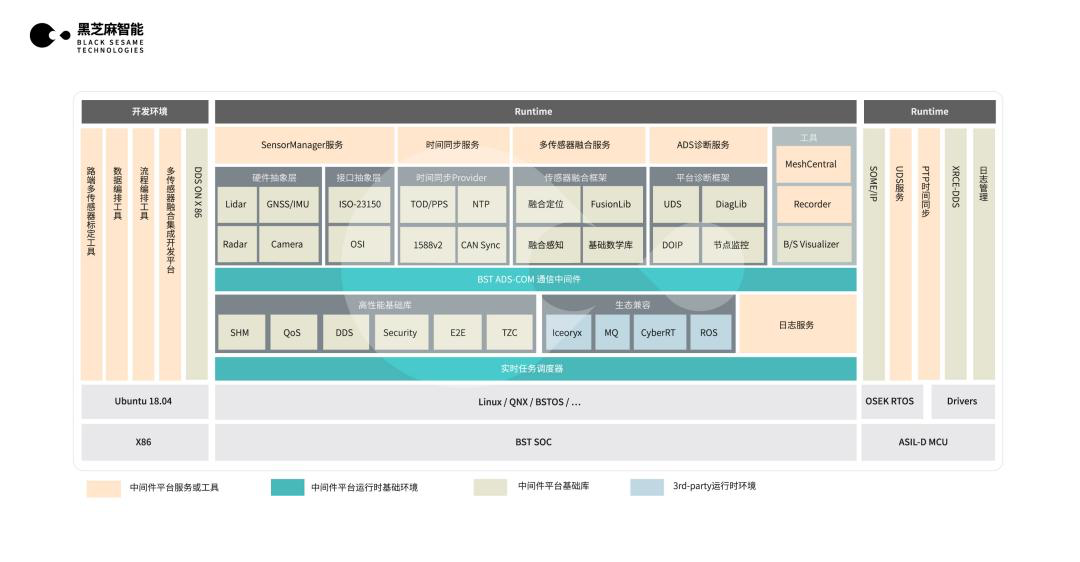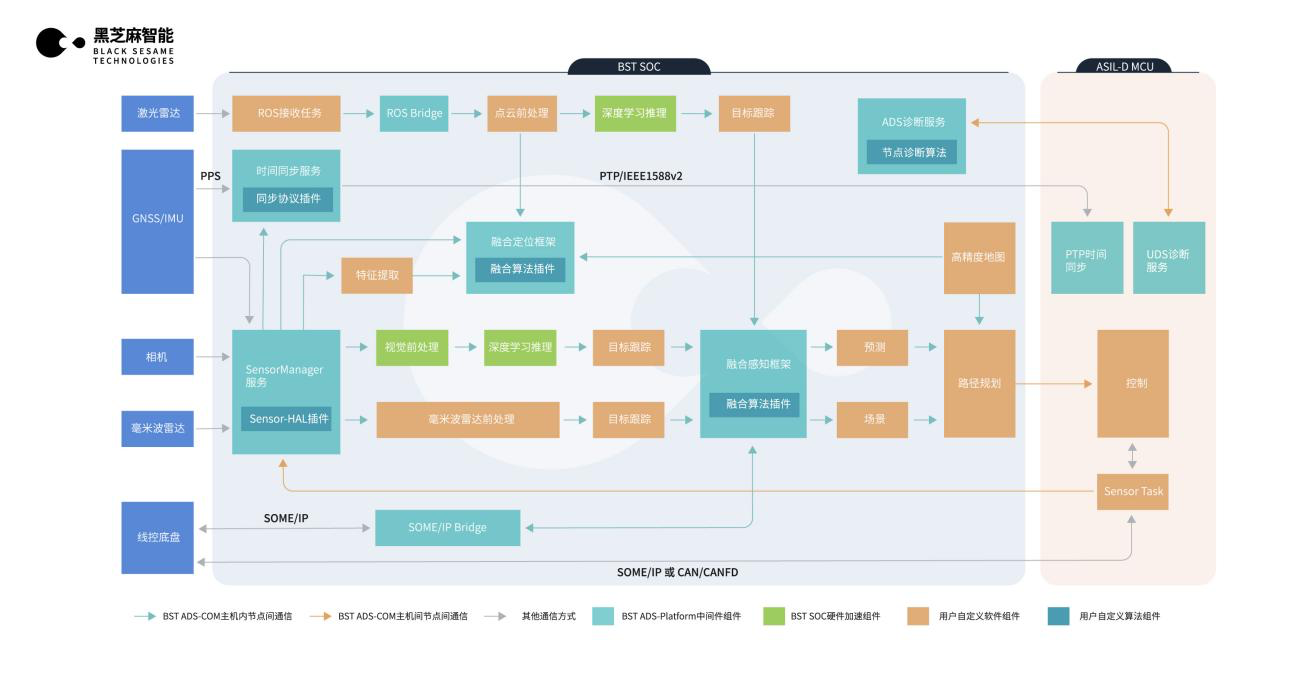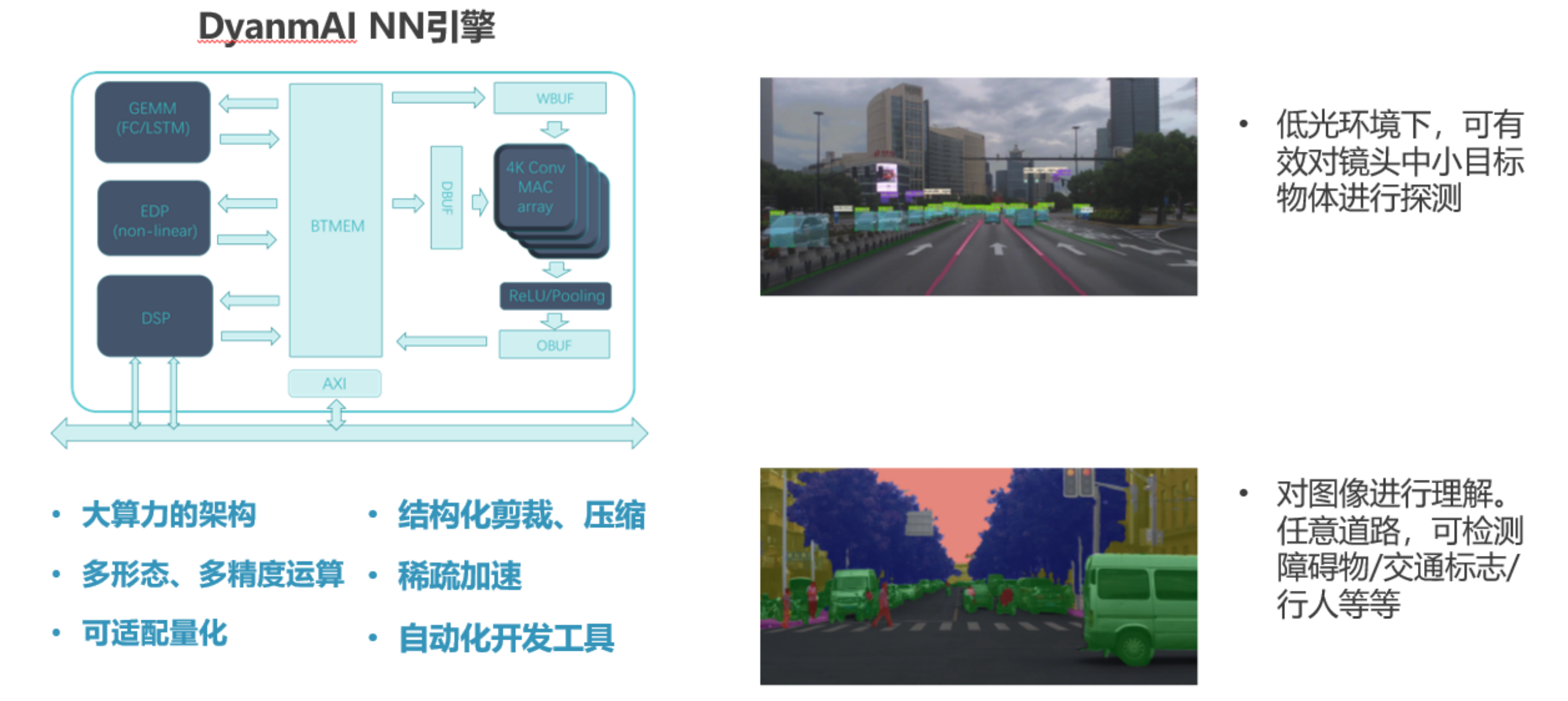Recently, self-driving chip company “Heizhima Intelligence” has released the Hanhai self-driving middleware platform. This middleware product allows users to quickly and easily access and use Heizhima Intelligence Huashan series chips, becoming an important part of the domestically-produced, high computational power, self-driving platform connected by Heizhima Intelligence.
What is Middleware?
With the advent of the “software-defined car” era, the EE architecture is gradually becoming centralized, and there are multiple coexisting operating systems in the automotive software system, which leads to system complexity and a dramatic increase in development costs.
In order to improve software management, portability, tailoring, and quality, it is necessary to redefine a set of architecture, methodology, and application interfaces, thus implementing standard interfaces, high-quality seamless integration, efficient development, and managing complex systems through new models, known as “middleware”.
Middleware is one of the “Three Musketeers” of basic software. As a bridge between application programs and operating systems, it can shield the heterogeneity of basic hardware, operating systems and communication protocols, and provide application developers with a unified, standard and interactive interface.
Middleware is of great significance for decoupling automotive software and hardware
As it needs to serve different customers and different car models, middleware can make the same products reused in different car models as much as possible, and make different Tier1 products compatible with each other, which can greatly reduce development costs.
At the same time, the increasingly complex software and different specifications of hardware platforms make the challenges faced by software and hardware combinations grow exponentially. Middleware plays a crucial role in this regard, making it easier for developers to develop self-driving software quickly, efficiently and flexibly.
The traditional development mode is to define functions, select hardware, and develop system software adapted to each chip platform. However, in recent years, with the rapid development of self-driving applications from low-end to high-end, this development model is no longer applicable.
At the same time, as the industry deepens its understanding of self-driving applications, it is widely believed that the future self-driving system software will be based on business-driven SOA development methods: it needs to meet current needs and have considerable foresight, compatibility, and scalability, which can support subsequent hardware and software upgrades and module requirements, allowing end customers to further expand functional application scenarios on the basis of current functions while improving the performance indicators of current functions.
The middleware designed for self-driving is exactly such a platform that can be adjusted as needed, meet more and more complex bottom-level hardware, sensor, and upper-level application flexible needs. It improves research and development efficiency, reduces development thresholds and comprehensive costs, and accelerates product mass production. Based on this consideration, Heizhima Intelligence has launched the Hanhai self-driving middleware platform.
Heizhima Intelligence’s Middleware PlatformThe Hanhai autonomous driving middleware platform from Black Sesame Intelligence is an intelligent driving platform SDK development kit based on the Huashan series autonomous driving calculation chip. It includes Target (SoC) SDK, X86 (host) SDK, and Target (MCU) SDK, which can support the development of vehicle-end, road-end, and various intelligent driving and vehicle-road coordination scenarios.

The Hanhai autonomous driving middleware is deeply optimized based on the high-performance Huashan series chips with high computing power, providing integrated functionality while ensuring running performance.
Specifically, the advantages of the Hanhai autonomous driving middleware are:
-
The communication component can transfer data between different processes of the chip through zero-copy, greatly reducing memory and system bandwidth usage.
-
This component can also be used for communication between chips, allowing existing devices to efficiently obtain data interconnect with the Huashan series chips.
-
The sensor abstraction component can achieve software and hardware decoupling using standard data structures, and the time synchronization middleware can achieve ns-level time synchronization by calling the hardware synchronization mechanism of the Huashan series chips.
In addition, the execution management-related component provides a series of diagnostic mechanism frameworks and real-time enhancement for the operating system, thereby improving diagnostic robustness and reducing thread-switching overhead.
Three SDK toolkits
Target (SoC) SDK
The Target (SoC) SDK provides a runtime environment on SOC and a compilation environment on the host, implements a real-time task scheduler for heterogeneous computing units, SensorManager for sensor access and management services, high-precision time synchronization service, multi-sensor fusion service, and ADS diagnostic service. All communications between BST ADS-Platform services and task nodes are based on the BST ADS-COM communication middleware, which can achieve high-performance DDS communication within/between processes/heterogeneous computing units/cross-hosts, and is compatible with CyberRT, ROS, and other middleware ecosystems.

X86 (Host) SDKThe X86 (Host) SDK includes multi-sensor calibration tools for vehicle-road collaborative roadside scenarios, data arrangement tools for recording, playback, visualization, and real-time analysis, process arrangement tools for task scheduling, resource monitoring, and visualization, and a sensor fusion integration development platform for multi-sensor fusion algorithm debugging, validation, and visualization. To communicate with the SOC end, the X86 SDK provides a DDS environment and a secondary development interface.
Target (MCU) SDK
The Target (MCU) SDK is aimed at ASIL-D MCU computing platforms, providing a secondary development SDK package for MCU end, supporting SOME/IP, PTP time synchronization (IEEE 1588v2), UDS on CAN diagnostic protocol, and logging system. In addition, the Target-side SDK provides a lightweight DDS framework XRCE-DDS, which can realize DDS communication with X86 and BST SOC platforms.
A small force may lever a great weight
The Heizhima Intelligent Hanhai autonomous driving middleware platform can not only help developers quickly develop intelligent driving applications and complete deployment but also reduce the development workload of upper-level applications and shorten the development time of the application.
Furthermore, the Hanhai autonomous driving middleware platform tries to allow the same product to be reused in different models and make different Tier1 products compatible with each other, thereby greatly reducing development costs.
About Heizhima Intelligence
Founded in 2016, Heizhima Intelligent Technology Co., Ltd has established research and sales centers in Wuhan, Silicon Valley, Shanghai, Chengdu, Shenzhen, Chongqing, and Singapore. Currently, it has more than 500 employees, and the core team comes from Bosch, OV, NVIDIA, and other industry-leading companies, with an average of over 15 years of industry experience.
Heizhima Intelligence is an enterprise dedicated to the development of vehicle-grade autonomous driving computing chips and platforms, focusing on research and development in technology fields such as high-computing chips and platforms, and providing complete autonomous driving and vehicle-road collaborative solutions, including autonomous driving sensing computing chips and autonomous driving computing platforms based on vehicle-grade design, learning-based image processing, low-power and precise perception. The products support the rapid industrialization of the autonomous driving industry chain.

Currently, Heizhima Intelligence has carried out commercial cooperation with FAW, Bosch, SAIC, Baidu, Dongfeng Yuxiang, T3, Junlian Zhixing, Zhongke Chuangda, Asia Pacific, etc., in L2/3 level ADAS and autonomous driving perception system solutions.In September 2021, Black Sesame Technologies completed hundreds of millions of dollars in strategic and Series C financing. The strategic round was invested by domestic industry leaders such as Xiaomi Changjiang Industrial Fund and Fusi Motors, while the Series C financing was led by Xiaomi Changjiang Industrial Fund, followed by Wentou Capital. After this round of financing, Black Sesame Technologies’ valuation has reached nearly $2 billion, making it a unicorn in the field of automotive chips.
This is also Xiaomi’s first investment in the automotive chip sector after announcing its car-making plan. Xiaomi Auto announced the development of a Level 4 autonomous driving system and collaborated with Black Sesame Technologies to help address its weaknesses. In the future, Xiaomi Auto may adopt Black Sesame Technologies’ autonomous driving computing chips and R&D platform.
So far, Black Sesame Technologies has released several chips, such as Huashan-1 A500, Huashan-2 A1000, and Huashan-2 A1000 Pro, which cover L2 to L4 level autonomous driving scenarios. Among them, the Huashan-2 A1000 Pro single-chip computing power is up to 196 TOPS, supporting advanced autonomous driving functions, seamlessly connecting parking, city internal, and high-speed driving scenes.
Huashan-2 A1000 chip series was released in June 2020. It was the first domestically produced chip that supports L2+ autonomous driving and also has the largest computing power and strongest performance among mass-produced autonomous driving computing chips in China. It has begun to ship to customers and will be implemented on vehicles later this year.
This article is a translation by ChatGPT of a Chinese report from 42HOW. If you have any questions about it, please email bd@42how.com.
